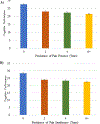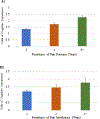Persistence of pain and cognitive impairment in older adults
- PMID: 34741304
- PMCID: PMC8821128
- DOI: 10.1111/jgs.17542
Persistence of pain and cognitive impairment in older adults
Abstract
Background: No studies have examined the longitudinal association between the persistence of pain and its relationship to cognitive problems in older adults. The objective of this study was to examine how the persistent of pain associates with cognitive performance, cognitive impairment, and subjective memory decline.
Methods: Across 10 biennial waves, 8515 adults ages 65 and over were assessed from the Health and Retirement Study (Mage = 74.17, SD = 6.87, 59.2% female). At each wave, individuals were asked to report on pain presence, and if present, rate its intensity and interference with daily activities such as housework or chores. Using running frequencies or averages, we calculated the persistence of pain using these three pain measures. Cognition was assessed using cognitive performance and different cognitive impairment cutoffs. Incident subjective memory decline was additionally measured as new self-reported memory change in the last 2 years. General estimating equations examined concurrent associations between persistence of pain and cognitive variables, adjusting for demographics, depressive symptoms, and medical comorbidities.
Results: Persistence of pain presence was associated with an increased risk of cognitive impairment. Only persistence of pain interference, not pain intensity, was significantly associated with poorer cognitive performance or being classified as cognitively impaired. For every 2 years, persistence of pain interference was associated with 21% increased odds of cognitive impairment. Only one of three pain variables was related to incident subjective memory decline.
Conclusions: Persistence of pain is associated with poorer cognitive performance in community-dwelling older adults, especially when involving ongoing interference in chores and work. Facilitating pain management might be important for helping to maintain later-life cognition and reduce dementia risk.
Keywords: chronic pain; cognition; cognitive impairment; pain; subjective memory.
© 2021 The American Geriatrics Society.
Conflict of interest statement
Figures



